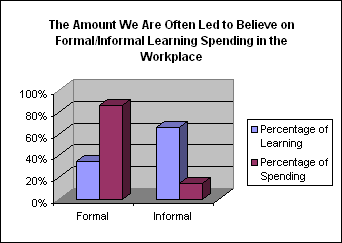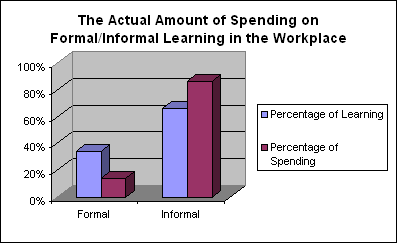ATD Blog
The Numbers Behind Informal & Formal Learning
Sun Feb 18 2007
I recently posted an article on this blog, Investing in Informal Learning. Seeing more in it that what I originally posted, I used it as part of a larger posting on trdev, State of the Learning Industry. Tony Karrer urged me to post it to Learning Circuits as trdev is semi-public in that you have to join the group to view any of the postings (it is free however). For those of you who are not members of trdev, I urge you to join as it is one of the more dynamic and critical T&D discussion groups on the web. However, simply cross-posting the same material holds no real interest to me, so I delved into the subject and thought about it some more. . .
I'm sure most readers of this blog have seen charts similar to this posted throughout the web:

Which of course makes informal learning look like a better investment than formal learning. However, in Training in America, the cost of formal and informal that they give ($30 billion for formal learning and $180 billion for informal learning) means that the true investment for learning should look more like this:

The second chart suggests that "formalizing" the informal learning would now be the better investment in order to make it more efficient. However, in the trdev discussion, Tony suggested that the second chart is not counting the payroll expenditures (soft costs) of the students in the formal learning classes. Thus the formal learning expenditures should be higher. We could argue back and forth about what costs should be included in each one, but we would only be second guessing what the authors actually counted under each form of learning.
Then it dawned on me what the numbers really mean; we are using the government's term of informal and formal learning -- if the money invested in learning falls under a training department's budget, it is counted as formal learning; if it falls only under payroll, then it is being counted as informal learning.
We are using monetary terms to define informal and formal learning. However, I think that most of us would define it more or less as Stephen Downes views it -- if it is managed by the learner it is informal, if it is managed by someone else it is formal.
The government defines OJT and apprenticeship programs as "informal" simply because they normally fall directly under payroll's budget, rather than training's. Yet for the most part, learners are not walking into the workplace and deciding what and how they will learn their job. Rather they are being directed or managed by supervisors and coworkers. The OJT programs are often under the guidance of the training department.
Thus the numbers thrown at us that 80% of the learning in the workplace is informal and 20% is formal is totally misleading, unless of course you want to define formal and informal learning in dollar terms. So what is the real percentage? I doubt if anyone really knows. Besides, I think it would totally depend on the type of workplace itself.
You've Reached ATD Member-only Content
Become an ATD member to continue
Already a member?Sign In
